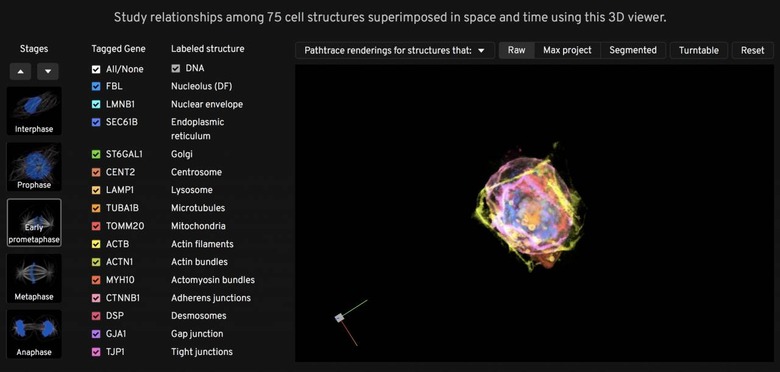This Groundbreaking Human Cell Division Model Could Help Cure Cancer
Scientists have released the first visualization of human cell division, paving the way for new potential treatments for cancer and other diseases. Mitosis is the process where healthy human cells divide, responsible for everything from growing a baby from a fertilized egg, through to our bodies repairing themselves.
While the processes which go into mitosis may be known, however, until now we've not seen them in action. It's an important distinction, according to scientists at the Allen Institute for Cell Science, since only when you view the holistic mechanism can you start to tease out how it fully works – and how it can go wrong.
The implications for the latter are significant. Cancer, for example, is the result of abnormal cell growth. The genes regulating growth and differentiation are altered, and then those errors self-amplify and eventually grow, in a chain reaction, into a more serious disease.
The Allen Institute researchers have released a new Allen Cell Explorer, a data-driven model and visualization tool that shows how human cells split. It illustrates how 15 different key cellular structures change their shape, duplicate, disappear, and reassemble in human stem cells, across the five stages of cell division. In a 3D viewer, users are able to explore that process from every angle.
The team used images of 75 representative cells, taken from a database of nearly 40,000 maintained by the organization. Each shows a live human stem cell line, gene-edited so that the different structures glow with fluorescent tags.
"These visualizations allow us to directly look at many different structures at once by superimposing them in the same space," Graham Johnson, Ph.D., Director of the Animated Cell team at the Allen Institute for Cell Science, said of the tool. "Now scientists can make and discuss more concrete, more accurate comparisons."
While it may happen naturally, the process of cell division is a fiendishly complex one. For a start, the cell replicates its chromosomes, the code that defines what the cell does. This copies are packages into two "daughter" cells, along with the other internal structures. The whole thing then splits, creating – in theory – two matching cells.
Problem is, if that duplication and partitioning process goes awry, cancer and other diseases can follow. One of the most common routes to abnormal cell growth is incorrect division, where one daughter cell has more chromosomes than it should, and the other too few. Actually seeing how that can happen, given the various factors in play, has been a struggle until now.

"Mitosis is pivotal for cancer and cancer cells. To date, research on mitosis and cancer has focused mainly on chromosomes, but very few things in a cell work in isolation," Tom Misteli, Ph.D., Director of the National Cancer Institute's Center for Cancer Research and a member of one of the Allen Institute for Cell Science's Scientific Advisory Councils, said of the research. "This new tool brings it all together, allowing researchers to connect the dots between different parts of the cell. We haven't had that until now."
Already, the visualization tool has helped researchers identify new elements to the mitosis process. For a start, there's what they're calling a "trigger point" in the early pro metaphase stage, where many of the 15 cellular structures suddenly undergo huge transformations. During the metaphase, meanwhile, just before division, the inter-cellular structure organization is at its least varied.
It's a long way from this tool to new ways to treat and potentially even cure or prevent cancers, of course. Still, better understanding of how cells replicate, and the ways that things can go wrong at each stage of that process, will be vital to figuring out new approaches to some of the deadliest diseases.
